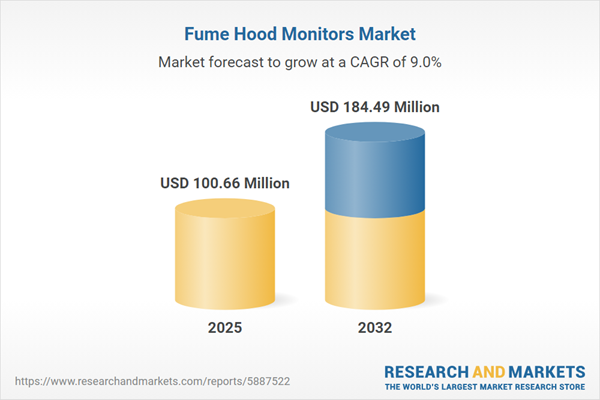Speak directly to the analyst to clarify any post sales queries you may have.
The fume hood monitors market is rapidly evolving as laboratories worldwide focus on improving safety, optimizing operations, and meeting stringent regulatory requirements. This shift is supported by intelligent monitoring systems that deliver precise, real-time environmental control and support strategic compliance initiatives.
Market Snapshot: Fume Hood Monitors Market Growth
The fume hood monitors market grew from USD 92.38 million in 2024 to USD 100.66 million in 2025. Continuing its upward trend, the market is expected to advance at a compound annual growth rate (CAGR) of 9.03%, reaching USD 184.49 million by 2032. This growth is being driven by the adoption of advanced monitoring technologies, regulatory updates, and the need for robust compliance and data management in laboratory environments.
Scope & Segmentation
- Type: Integrated fume hood monitoring systems, Standalone monitoring units
- Installation Type: New installations, Retrofit projects
- End User: Academic and research institutes, Chemical industry, Healthcare sector, Pharmaceutical and biotech companies
- Channel: Direct sales, Distributors, Online procurement
- Application: Compliance monitoring, Data logging, Safety monitoring
- Technology: Wired technology, Wireless technology
- Geographical Coverage:
- Americas: North America (United States, Canada, Mexico), Latin America (Brazil, Argentina, Chile, Colombia, Peru)
- Europe, Middle East & Africa: Europe (United Kingdom, Germany, France, Russia, Italy, Spain, Netherlands, Sweden, Poland, Switzerland), Middle East (United Arab Emirates, Saudi Arabia, Qatar, Turkey, Israel), Africa (South Africa, Nigeria, Egypt, Kenya)
- Asia-Pacific: China, India, Japan, Australia, South Korea, Indonesia, Thailand, Malaysia, Singapore, Taiwan
- Company Coverage: Thermo Fisher Scientific Inc., Siemens AG, Emerson Electric Co., Honeywell International Inc., TSI Incorporated, Labconco Corporation, Kewaunee Scientific Corporation, Avantor, Inc., Drägerwerk AG & Co. KGaA, Nuaire Limited
Key Takeaways for Decision-Makers
- Advanced fume hood monitors enhance laboratory safety by providing accurate, real-time detection of airflow and environmental parameters, supporting compliance and energy optimization.
- Recent increases in environmental and occupational safety standards are prompting organizations to invest in intelligent systems capable of continuous monitoring and auditable data records.
- The shift from reactive servicing to proactive asset management is accelerating due to the integration of machine learning analytics and digital twin models in monitoring solutions.
- Wireless connectivity and Internet of Things (IoT) architectures allow laboratories to deploy flexible, remotely managed sensor networks, streamlining installation and reducing maintenance requirements.
- Segmenting the market by system configuration, installation scenario, and end-user vertical enables tailored deployment strategies that align with organizational priorities and legacy infrastructure needs.
- Channel preferences and technology choice (wired versus wireless) can influence both procurement speed and cybersecurity considerations, making strategic planning crucial for sustainable investments.
Tariff Impact: United States Market and Global Supply Chains
Newly imposed United States tariffs on imported sensors and electronic components are projected to affect supply chain costs and sourcing decisions within the fume hood monitoring market. Organizations are responding by reassessing supplier relationships, considering dual sourcing, and adopting modular system designs to buffer against tariff-related risks and volatility.
Methodology & Data Sources
The findings in this report are based on a combination of primary interviews with laboratory management, safety officers, and market suppliers, as well as secondary research including regulatory analysis, technical whitepapers, and company disclosures. Quantitative trends were validated through data triangulation and scenario analysis to ensure reliable insights for strategic planning.
Why This Report Matters
- Guides senior decision-makers in optimizing procurement and deployment of fume hood monitoring technologies to support safety and efficiency objectives.
- Delivers clear market segmentation and actionable forecasts, enabling organizations to align investments with evolving compliance demands and regional priorities.
- Provides a foundation for understanding technology adoption pathways and supplier differentiation strategies in a competitive landscape.
Conclusion
The fume hood monitors market is undergoing significant transformation, driven by regulatory, technological, and operational shifts. Organizations that proactively adopt flexible, intelligent monitoring solutions will be best positioned to enhance laboratory safety, maintain compliance, and achieve ongoing operational gains.
Additional Product Information:
- Purchase of this report includes 1 year online access with quarterly updates.
- This report can be updated on request. Please contact our Customer Experience team using the Ask a Question widget on our website.
Table of Contents
3. Executive Summary
4. Market Overview
7. Cumulative Impact of Artificial Intelligence 2025
Companies Mentioned
The companies profiled in this Fume Hood Monitors market report include:- Thermo Fisher Scientific Inc.
- Siemens AG
- Emerson Electric Co.
- Honeywell International Inc.
- TSI Incorporated
- Labconco Corporation
- Kewaunee Scientific Corporation
- Avantor, Inc.
- Drägerwerk AG & Co. KGaA
- Nuaire Limited
Table Information
| Report Attribute | Details |
|---|---|
| No. of Pages | 190 |
| Published | October 2025 |
| Forecast Period | 2025 - 2032 |
| Estimated Market Value ( USD | $ 100.66 Million |
| Forecasted Market Value ( USD | $ 184.49 Million |
| Compound Annual Growth Rate | 9.0% |
| Regions Covered | Global |
| No. of Companies Mentioned | 11 |









